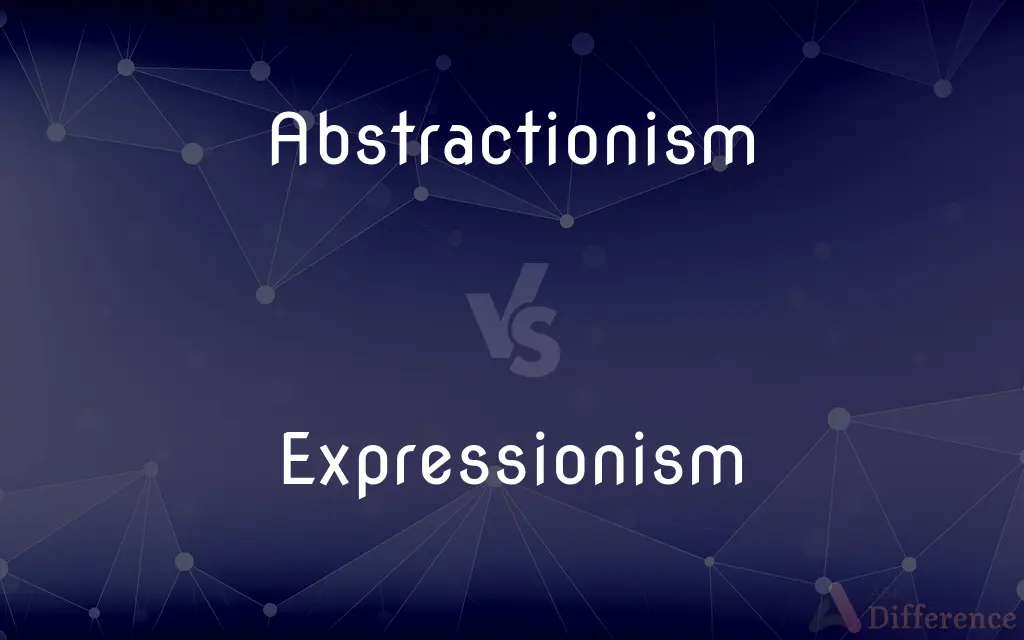Abstractionism vs. Expressionism — What's the Difference?
By Tayyaba Rehman & Urooj Arif — Updated on April 8, 2024
Abstractionism emphasizes non-representational art forms, focusing on elements like color, shape, and form, whereas Expressionism seeks to convey emotional experience, often through distorted and exaggerated imagery.

Difference Between Abstractionism and Expressionism
Table of Contents
ADVERTISEMENT
Key Differences
Abstractionism is an art movement that prioritizes the use of abstract elements color, shape, form to create compositions that may not represent real-world objects, aiming to evoke emotions or ideas without direct depiction. This movement seeks to break away from traditional representation of physical objects. In contrast, Expressionism, while also emotional in its intent, often uses exaggerated and distorted versions of the real world to express intense emotional experiences or viewpoints, making the inner feelings visible through art.
While abstractionism moves away from depicting reality to focus on the essence of objects or thoughts through shapes, colors, and textures, Expressionism distorts reality to highlight emotional or psychological states. For example, an abstract artist might use a series of geometric shapes to explore the concept of conflict, whereas an expressionist artist might depict a figure in a distorted, surreal landscape to convey feelings of angst or turmoil.
Abstractionism can range from partial abstraction, where the reference to the real world is vague or stylized, to complete abstraction, where there is no recognizable subject matter at all. Expressionism, on the other hand, despite its distortion, usually retains some connection to the real world, making it identifiable but interpreted through a subjective lens.
In abstractionism, the viewer is often invited to interpret the artwork in their own way, finding meaning in the visual elements and their composition. Expressionist art, while also open to interpretation, more directly communicates the artist's emotional intent, whether it be turmoil, ecstasy, or despair, often making it more immediately impactful but also more specific in its emotional expression.
Both movements reflect a departure from realism, emphasizing the importance of individual perception and emotional response to art. However, abstractionism abstracts reality to a point where the recognizable world might be completely absent, focusing on the aesthetic qualities and conceptual frameworks, while expressionism transforms reality to convey the emotional or spiritual reality behind the physical world.
ADVERTISEMENT
Comparison Chart
Focus
Non-representational elements (color, shape)
Emotional experience through distorted imagery
Depiction of Reality
Often completely abstract, no real-world objects
Distorted but recognizable real-world references
Emotional Expression
Elicited through abstract elements
Directly communicated through distortion
Viewer's Role
Interpretation based on visual elements
Engage with the artist's expressed emotions
Examples
Mondrian's grid compositions
Munch's "The Scream"
Compare with Definitions
Abstractionism
An art movement focusing on the abstract qualities of art.
Kandinsky's compositions epitomize abstractionism by eliminating recognizable subjects.
Expressionism
Uses distortion and exaggeration to convey feelings.
Expressionist artists distort reality to express their inner turmoil or passion.
Abstractionism
Emphasizes shapes, colors, and forms over recognizable scenes.
Abstractionism often relies on geometric forms to convey meaning.
Expressionism
Aims to make the internal external.
Expressionism turns inner feelings into visible forms, making the invisible visible.
Abstractionism
Art that does not depict objects as they are seen in the real world.
Abstract art challenges viewers to find personal meaning in the artwork.
Expressionism
Often portrays the world from a subjective perspective.
Expressionist art represents a personal, subjective view of the world.
Abstractionism
Aims to express concepts or emotions indirectly.
Abstractionism can evoke a range of emotions through simple shapes and colors.
Expressionism
An art movement that expresses emotional experience over physical reality.
Van Gogh's 'Starry Night' is often cited as an example of expressionism.
Abstractionism
Engages viewers in interpretation and contemplation.
An abstractionism exhibit encourages viewers to explore their own responses to art.
Expressionism
Seeks to evoke an emotional response in the viewer.
Expressionism's bold colors and dramatic compositions impact viewers on an emotional level.
Abstractionism
Abstractionism is the theory that the mind obtains some or all of its concepts by abstracting them from concepts it already has, or from experience. One may, for example, abstract 'green' from a set of experiences which involve green along with other properties.
Expressionism
Expressionism is a modernist movement, initially in poetry and painting, originating in Northern Europe around the beginning of the 20th century. Its typical trait is to present the world solely from a subjective perspective, distorting it radically for emotional effect in order to evoke moods or ideas.
Abstractionism
The theory and practice of abstract art.
Expressionism
A movement in the arts during the early 1900s that emphasized distortion of external reality in order to express the artist's subjective experience.
Abstractionism
The creation, principles, or ideals of abstractions, in particular art.
Expressionism
A movement in the arts in which the artist did not depict objective reality, but rather a subjective expression of their inner experiences
Abstractionism
The presentation of ideas in an abstract manner.
Expressionism
A somewhat analogous genre in early 20th century music
Abstractionism
An abstract genre of art; artistic content depends on internal form rather than pictorial representation
Expressionism
An art movement early in the 20th century; the artist's subjective expression of inner experiences was emphasized.
Abstractionism
A representation having no reference to concrete objects or specific examples
Expressionism
A genre of German painting that tried to show the subjective responses to scenes rather than the scenes themselves.
Expressionism
An art movement early in the 20th century; the artist's subjective expression of inner experiences was emphasized; an inner feeling was expressed through a distorted rendition of reality
Common Curiosities
What is abstractionism in art?
Abstractionism is an art movement focusing on creating compositions using abstract elements like color, shape, and form, without representing real-world objects, to evoke emotions or ideas.
What defines expressionism?
Expressionism is defined by its focus on conveying emotional experience through art, often using distorted and exaggerated imagery to represent the artist's subjective viewpoint.
How do historical contexts influence abstractionism and expressionism?
Both movements emerged in the early 20th century as reactions to realism and the changing world, reflecting a shift towards exploring internal perspectives and emotional responses.
Can an artwork be both abstract and expressionist?
Yes, artworks can incorporate elements of both movements, using abstraction to convey emotional experiences in a non-representational manner.
How do abstractionism and expressionism differ in their approach to reality?
Abstractionism abstracts reality, often eliminating recognizable subjects, whereas expressionism distorts reality to emphasize emotional or psychological states.
Can abstract art evoke emotions without depicting real objects?
Yes, abstract art can evoke a wide range of emotions through its use of visual elements like colors and shapes, even without depicting recognizable objects.
Why do artists choose abstractionism or expressionism?
Artists may choose these styles to explore the possibilities of art beyond traditional representation, expressing ideas and emotions in unique and innovative ways.
What role does the viewer play in interpreting abstractionism and expressionism?
In abstractionism, the viewer plays a critical role in interpreting the artwork based on its abstract elements. In expressionism, viewers engage more directly with the artist's expressed emotions, though interpretation remains important.
Are abstractionism and expressionism limited to painting?
No, both movements extend beyond painting to include sculpture, literature, and other art forms, though they are most commonly associated with visual arts.
How do abstractionism and expressionism influence modern art?
These movements have profoundly influenced modern and contemporary art, challenging artists to explore new ways of seeing and representing the world around them.
Share Your Discovery

Previous Comparison
Lobotomy vs. Lobectomy
Next Comparison
Inclination vs. TendencyAuthor Spotlight
Written by
Tayyaba RehmanTayyaba Rehman is a distinguished writer, currently serving as a primary contributor to askdifference.com. As a researcher in semantics and etymology, Tayyaba's passion for the complexity of languages and their distinctions has found a perfect home on the platform. Tayyaba delves into the intricacies of language, distinguishing between commonly confused words and phrases, thereby providing clarity for readers worldwide.
Co-written by
Urooj ArifUrooj is a skilled content writer at Ask Difference, known for her exceptional ability to simplify complex topics into engaging and informative content. With a passion for research and a flair for clear, concise writing, she consistently delivers articles that resonate with our diverse audience.
















































